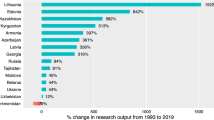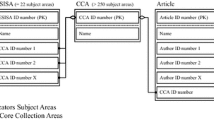Abstract
This study aims to find a global pattern of the Triple Helix (TH) relationship among university, industry, and government sectors in scientific research, placing the discussion in a developmental context. Based on the dataset composed of SCI and SSCI-listed publications from around 130 countries, we investigated the participation share of each sector, the publication share by sector and sectoral combination, and the synergic effect of the TH relationship. Statistical analyses suggest the presence of a dividing pattern of the TH relationship between developed and developing countries: Developed countries had higher participation in the industry sector, more university-centered collaborations with the industry and government sectors, and a higher synergic effect of the TH relationship than developing countries. This tendency was found to occur irrespective of the science or social science field. These findings have implications for developing countries to promote the participation of the industry sector in scientific research and the effort of the government sector to facilitate university and industry linkage.


Similar content being viewed by others
Notes
The percentages were calculated by the authors for those countries that we were able to classify into developing and developed categories. For more information about QS rankings, please refer to http://www.topuniversities.com/qs-world-university-rankings.
The research and development expenditure of 2010 had the fewest missing values among the data of recent years. The percentages were calculated by the authors for those countries that we were able to classify into developing and developed categories. Detailed information about research and development investment can be retrieved from http://data.worldbank.org/indicator/GB.XPD.RSDV.GD.ZS.
The average values were estimated by the authors for those countries that we were able to classify into developing and developed countries. The number of patent applications is based on resident count by filing office. More information can be found in http://www.wipo.int/ipstats/en/statistics/patents/.
References
Amir, S., Nugroho, Y.: Beyond the triple helix: framing STS in the developmental context. Bull. Sci. Technol. Soc. (2013). doi:10.1177/0270467613509603
Chen, W., Wellman, B.: The global digital divide—within and between countries. IT Soc. 1(7), 39–45 (2004)
Chilote, R.: Dependency: a critical synthesis of the literature. Latin Am. Perspect. 1(1), 4–29 (1974)
Choi, S., Park, H.W.: Flow of online content from production to consumption in the context of globalization theory. Globalizations 11(2), 171–187 (2014)
Choi, S., Yang, J.S.W., Park, H.W.: The triple helix and international collaboration in science. J. Assoc. Inf. Sci. Technol. (2014). doi:10.1002/asi.23165
Etzkowitz, H.: The triple helix: science, technology and the entrepreneurial spirit. J. Knowl. Based Innov. China 3(2), 76–90 (2011)
Etzkowitz, H.: Can a teaching university be an entrepreneurial university? Civic entrepreneurship and the formation of a cultural cluster in Ashland, Oregon. CIMR Research Working Paper Series. CA: Centre for Innovation Management Research (2013)
Etzkowitz, H., Dzisah, J.: Rethinking development: circulation in the triple helix. Technol. Anal. Strateg. Manag. 20(6), 653–666 (2008)
Etzkowitz, H., Leydesdorff, L.: The triple helix of university–industry–government relations: a laboratory for knowledge based economic development. EASST Rev. 14(1), 11–19 (1995)
Etzkowitz, H., Webster, A., Gebhardt, C., Terra, B.R.C.: The future of the university and the university of the future: evolution of ivory tower to entrepreneurial paradigm. Res. Policy 29(2), 313–330 (2000)
Eun, J.H., Lee, K., Wu, G.: Explaining the “University-run enterprises” in China: a theoretical framework for university–industry relationship in developing countries and its application to China. Res. Policy 35(9), 1329–1346 (2006)
Frenken, K., Hardeman, S., Hoekman, J.: Spatial scientometrics: towards a cumulative research program. J. Inf. 3, 222–232 (2009)
Gibbons, M., Limoges, C., Nowotny, H., Schwartzman, S., Scott, P., Trow, M.: The New Production of Knowledge: The Dynamics of Science and Research in Contemporary Societies. Sage, London (1994)
Glänzel, W., Schlemmer, B.: National research profiles in a changing Europe (1983–2003): an exploratory study of sectoral characteristics in the Triple Helix. Scientometrics 70(2), 267–275 (2007)
Jiang, K.: International Sstudent flows between Asia, Australia, and Russia: a network analysis. J. Contemp. Eastern Asia 13(1), 83–98 (2014). http://eastasia.yu.ac.kr/Ke_13_1.pdf
Khan, G.F., Park, H.W.: Measuring the triple helix on the web: longitudinal trends in the university–industry–government relationship in Korea. J. Am. Soc. Inform. Sci. Technol. 62(12), 2443–2455 (2011)
Khan, G.F., Park, H.W.: The e-government research domain: a triple helix network analysis of collaboration at the regional, country, and institutional levels. Gov. Inf. Q. 30(2), 182–193 (2013)
Kim, H., Huang, M., Jin, F., Bodoff, D., Moon, J., Choe, Y.C.: Triple helix in the agricultural sector of Northeast Asian countries: a comparative study between Korea and China. Scientometrics 90(1), 101–120 (2012)
Krippendorff, K.: Information of interactions in complex systems. Int. J. Gen. Syst. 38(6), 669–680 (2009)
Leydesdorff, L.: The mutual information of university–industry–government relations: an indicator of the triple helix dynamics. Scientometrics 58(2), 445–467 (2003)
Leydesdorff, L., Etzkowitz, H.: The triple helix as a model for innovation studies. Sci. Public Policy 25(3), 195–203 (1998)
Leydesdorff, L., Sun, Y.: National and international dimensions of the triple helix in Japan: university–industry–government versus international coauthorship relations. J. Am. Soc. Inform. Sci. Technol. 60(4), 778–788 (2009)
Leydesdorff, L., Ivanova, I.A.: Mutual redundancies in interhuman communication systems: steps toward a calculus of processing meaning. J. Assoc. Inf. Sci. Technol. 65(2), 386–399 (2014)
Mehta, M.D.: Nanoscience and nanotechnology: assessing the nature of innovation in these fields. Bull. Sci. Technol. Soc. 22(4), 269–273 (2002)
Merton, R.K.: Science and technology in a democratic order. J. Legal Polit. Sociol. 1, 115–126 (1942)
Mok, K.H.: The quest for innovation and entrepreneurship: the changing role of university in East Asia. Glob. Soc. Educ. 10(3), 317–335 (2012)
Park, H.W., Hong, H.D., Leydesdorff, L.: A comparison of the knowledge-based innovation systems in the economies of South Korea and The Netherlands using triple helix indicators. Scientometrics 65(1), 3–27 (2005)
Park, H.W., Leydesdorff, L.: Longitudinal trends in networks of university–industry–government relations in South Korea: the role of programmatic incentives. Res. Policy 39(5), 640–649 (2010)
Phillips, F.: Triple helix and the circle of innovation. J. Contemp. Eastern Asia 13(1), 57–68 (2014). http://eastasia.yu.ac.kr/Phillips_13_1.pdf
Ponds, R., Van Oort, F.G., Frenken, K.: The geographical and institutional proximity of research collaboration. Pap. Reg. Sci. 86, 423–443 (2007)
Rho, W.-J.: Triple helix for social innovation: the Saemaul undong for eradicating poverty. J. Contemp. Eastern Asia 13(1), 39–55 (2014). http://eastasia.yu.ac.kr/Rho_13_1.pdf
Saad, M., Zawdie, G., Malairaja, C.: The triple helix strategy for universities in developing countries: the experiences in Malaysia and Algeria. Sci. Public Policy 35(6), 431–443 (2008)
Shannon, C.E.: A mathematical theory of communication. Bell Syst. Tech. J. 27, 379–423, 623–656 (1948)
Senker, J.: A Ttransnational Investigation of University-Industry Linkages in Advanced Engineering Ceramic. Science Policy Research Unit, University of Sussex, Sussex, UK (1994)
Schiller, H.: Not yet the post-imperialist era. Crit. Stud. Mass Commun. 8(1), 13–28 (1991)
Steiber, A., Alänge, S.: The formation and growth of Google: a firm-level triple helix perspective. Soc. Sci. Inf. 52(4), 575–604 (2013)
Wallerstein, I.: The rise and future demise of the world capitalist system: concepts for comparative analysis. Comp. Stud. Soc. Hist. 16(4), 387–415 (1974)
Ye, F.Y., Yu, S.S., Leydesdorff, L.: The triple helix of university–industry–government relations at the country level and its dynamic evolution under the pressures of globalization. J. Am. Soc. Inf. Sci. Technol. 64(11), 2317–2325 (2013)
Ziman, J.: Prometheus Bound: Science in a Dynamic Steady State. Cambridge University Press, Cambridge, UK (1994)
Acknowledgments
This work was supported by the National Research Foundation of Korea Grant funded by the Korean Government (NRF-2010-330-B00232, Social Science Korea Program). Many thanks go to Min-Ho So, Seong-Cheol Choi, Ji-Young Kim, Ji-Won Park, Yoon-Cheol Heo, Ji-Young Park.
Author information
Authors and Affiliations
Corresponding author
Rights and permissions
About this article
Cite this article
Choi, S., Yang, J.S. & Park, H.W. Quantifying the Triple Helix relationship in scientific research: statistical analyses on the dividing pattern between developed and developing countries. Qual Quant 49, 1381–1396 (2015). https://doi.org/10.1007/s11135-014-0052-5
Published:
Issue Date:
DOI: https://doi.org/10.1007/s11135-014-0052-5




